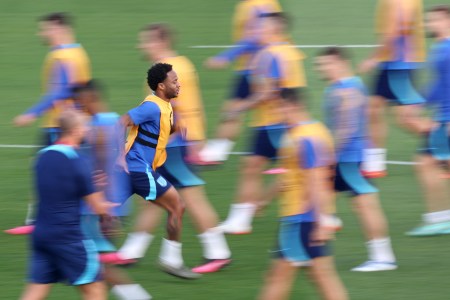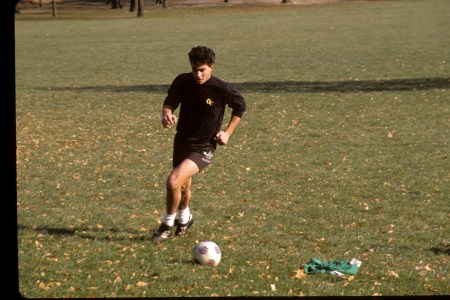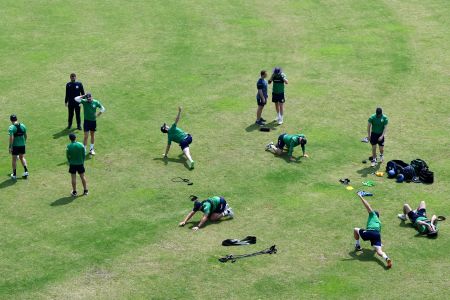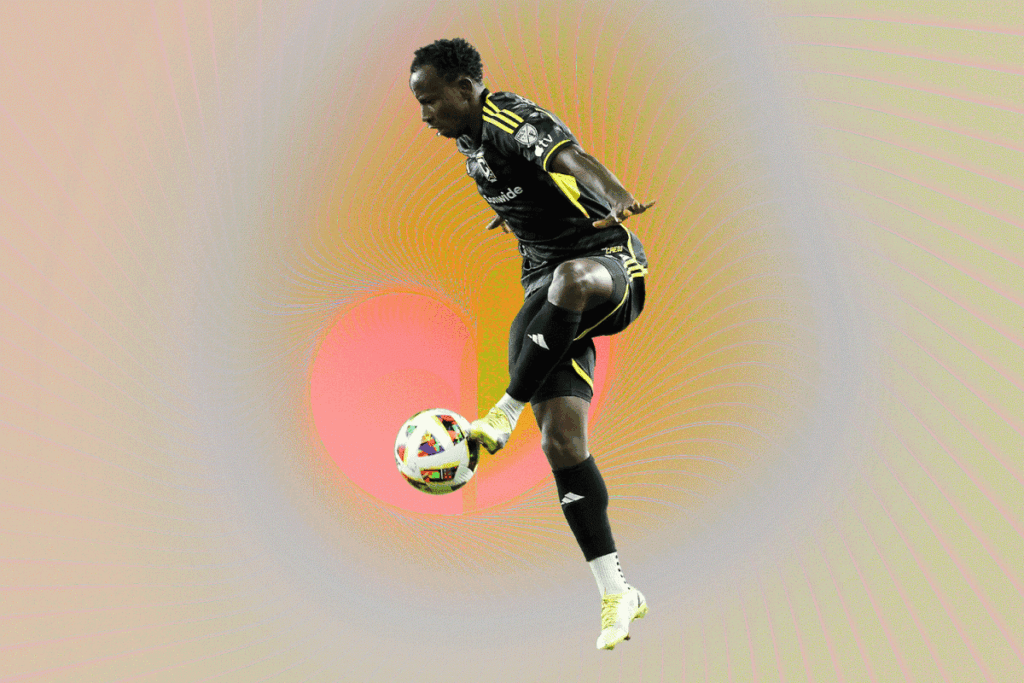Shortly after the last whistle blew at Major League Soccer’s Eastern Conference Final in December, Cucho Hernández, the 24-year-old forward for match victors the Columbus Crew, jogged from about the halfway point of the field all the way to a corner section of the stands, blowing kisses to his team’s fans. On his way over, he passed several members of F.C. Cincinnati, the defeated home squad, lying on the ground exhausted. The epic, extra-time contest lasted 120 minutes. Cucho, as he’s most commonly called, looked as enlivened on the pitch as he did when it started.
Just 10 minutes earlier, he made a run toward the goal as teammate Kevin Molino skied a pass from the top of the penalty area to the far post. Instead of taking a shot, Cucho still had the energy and presence of mind to leap up and ping a header pass onto the foot of striker Christian Ramirez, who’d also beaten his man to the front of the goal. Ramirez tapped Cucho’s ball forward, rippling the net, and the Crew were on their way to the MLS Cup Final.
But by that point in the game, and for at least a half hour prior, a winning goal for Columbus felt inevitable. Down 2-0 in the 75th minute, Cincinnati scored an own goal to cut the Crew’s deficit in half. “They got the [first] goal and then I thought we kind of just ran out of legs from chasing them around for 80 minutes,” said Cincinnati goalkeeper Alec Kann a few days afterward. “They were able to knock on the door and eventually broke their way in.”
In the 85th minute, Diego Rossi, another Crew forward, scored the equalizer. At the end of regulation, Apple TV+ announcer Jake Zivin said Cincinnati’s players looked “heavy legged,” and 10 minutes later, Zivin’s game analyst, Taylor Twellman, said they were “chasing shadows,” unable to keep up with the Crew, who were still flying around the pitch. Watching the Ramirez goal replay after it was scored, Twellman remarked that it was “amazing” to watch the Crew play at such a quick pace for what was then 114 minutes. “They look fresh; Cincinnati does not,” agreed Zivin. “They look beat and they have for some time.”
One week later, the Crew were crowned MLS Cup Champions for 2023, as they zipped around their home pitch in a clinical takedown of the previous year’s titleholders, the Los Angeles Football Club. But what made the Crew’s victory in Cincinnati most impressive wasn’t just the high-octane performance they gave that night through extra time; it was the fact that it was the second consecutive week they won a game that lasted so long.
It’s safe to say, then, that the Crew didn’t win a title just because they were the highest-scoring team in MLS last year. All those goals, particularly the ones scored past the 100-minute mark in late-season playoff matches, had something to do with the players’ extreme dedication to fitness.
For the world’s best soccer players, it takes deliberate choices — made every single day, in virtually every single thing they do — to compete at the highest level. Here are precise details on how they do it.

The End Game
Soccer players famously run a ton. Midfielders cover the most ground in a game, as they’re more responsible for both offensive and defensive duties than defenders and forwards are. Estimates of the average midfielder per-match run distance typically fall in the range of seven to nine miles. That’s nearly triple the distance the average tennis player runs in their matches, and more than six times what the average NFL wide receiver runs in a game.
But in addition to all that running, soccer players must dribble and pass the ball, box out opponents, jump for headers in aerial duels (when two players compete for a ball in the air), slide-tackle opposing players and perform all sorts of other athletic maneuvers. It’s no wonder, then, that pro soccer players burn around 1,500 calories during a match.
Jules Gueguen, assistant coach/fitness coach for the Columbus Crew, says soccer is “the most complete” sport when it comes to fitness strategies because of all that is asked of the players. (Though he puts rugby in the same category, too.) “They need to [have] endurance; they need to have volume; they need to be strong, for impacts and for pure strength as an athlete,” Gueguen says. “But then they also need to be powerful, and also need an endurance of power; they need to repeat the actions for 90 minutes.” Or sometimes 120 minutes, in back-to-back weeks, at the end of a nine-and-a-half-month season.
How to Prepare for Match Day
Gueguen says he and his fitness team coaches set up “microcycles” to determine how the players will train in a week’s time, leading up to Saturday match days. As MLS Cup winners, the Crew earned the right to compete in the Concacaf Champions Cup tournament, which injects a number of midweek games into their schedule. In order to prepare for this situation — during weeks when there are no midweek games — Gueguen says the staff combine training sessions on Tuesdays and Wednesdays that require players to take on 120% of a game load.
Tuesdays are steeped in exercises in “small spaces,” he says, to build power. They also do anaerobic exercises that do not force your body to use oxygen the way cardio exercises do. Per WebMD, “Anaerobic exercise involves short, fast, high-intensity exercises that…break down glucose that’s already in your muscles for a form of energy.” The site says that calisthenics, such as jump squats, box jumps and plyometrics, among others, qualify as anaerobic exercises. Gueguen says soccer players often find themselves in anaerobic states during matches because they are so intense, with repeated bursts of action.
“On a Tuesday we [run] low distances, like three to four kilometers (that’s 1.8 to 2.5 miles), but everything is explosive, everything is intense,” he says. On Wednesdays, the pitch is opened up and players run between 10 and 12 kilometers (around 6 to 7.5 miles). “But inside the 12 kilometers of a game, there are 500 meters of sprints, 1,000 meters of high-speed running, so it’s like long-distance, quick-intensity runs,” he explains. “There are 120 accelerations, so it’s very aggressive. So we need to be able to sustain that through the midweek — Tuesday, Wednesday — to make them better condition[ed] for the weekend.”
Jim Liston, director of high performance and innovation for the MLS Club the Los Angeles Galaxy, outlines a similar schedule in his camp.
“On Tuesday, we focus on accelerations and decelerations; on Wednesday, we play big numbers, often 11 v. 11,” he says. “On Thursday, we sprint, and we want to make sure guys hit above 88% of the max velocity. On Friday, it’s a day to refresh, so it’s a super short session. And then Saturday, they play.”
In terms of measurables, the fitness team’s focus for L.A. Galaxy players, Liston says, includes distance covered, sprint distance covered and “the number of max high-intensity bouts.” He explains that those are “accelerations and decelerations — so change in direction — because the game does have that demand.” The players wear Catapult GPS vests (the ones that resemble sports bras) to capture these data points.
The final numbers vary a bit due to differing position demands, but Liston says Galaxy players on average cover about 2.5 to 3 miles on Tuesday, 4-ish miles on Wednesday, roughly 2.5 miles on Thursday and a smidge under 2 miles on Friday.
“If you have a player that runs, typically, eight miles in a match…then they would run about 16 miles over the course of four days” leading up to match day, Liston says. “If you can imagine somebody who’s training for a 10K, they may periodize and do something similar to that.”
When it comes to sprint distance, the players get to 130% of what they would cover in a game — roughly two-thirds of a mile, running as fast as 12 mph — and then attain a similar figure for the high-intensity bouts.

Wait, There’s More
But…that just covers the running. In each of the four days leading up to a match, Galaxy players also hit the gym for weight training.
“For the starters, [on Tuesday] it will be more upper body, core, and mobility for the lower body,” Liston begins. “And then three days before [the match], it’s full-body, where the focus is definitely on strength and power of the lower body. That’s our heavy day.”
Thursday is another full-body day, albeit a slightly lighter one, while Friday is for the “arm farm” gang, says Liston. “They’re like, ‘sun’s out, guns out,’ so they might do a little upper-body lift on the day before the game.”
The Diet
If you haven’t already pieced this together, soccer players have to eat a lot, not just to create energy to burn, but also to help their bodies recover from matches. This is perhaps one of the most enjoyable parts of keeping fit like a soccer star, though you still have to make responsible decisions.
Back in the Columbus Crew camp, Gueguen says diet is “tricky” for player performance managers in part because culture has to be considered, as well as individual digestive systems, so “you need to be really flexible.” The players’ diets, therefore, are not “rigid,” he says, but the team does keep track of body-fat percentage and other measurables, requiring full-body DEXA scans of the players four times a year to make sure they’re maintaining favorable fitness ratings.
Erica Capellino, the L.A. Galaxy’s sports performance dietician, says her team’s players also enjoy a great degree of freedom in their nutritional choices, picking a routine that works best for them. Capellino, along with Ashley Porterfield, another team staffer who’s focused on player nutrition, helps the players build what they call “performance plates.” For each meal, half the plate consists of fruits and vegetables, while a quarter of the plate is reserved for lean protein — chicken or fish, typically — and the final quarter is filled with whole grains — brown rice or whole wheat bread. But the performance plates can vary based on nutrition and performance goals.
“For example, somebody who was looking to gain weight or needed more fuel and energy and calories, their plate would actually be half whole grains and carbs,” Capellino says. “A weight-maintain or a moderate-training plate, that basically splits your plate into thirds: a third fruit and veggies, a third protein, a third carbs.”
Carbohydrate loading happens before matches, but also after them so that players can replenish their glycogen stores, which are tapped out during games. Players on the Galaxy are even encouraged to eat shortly before bed. “Some recovery [tips] that we recommend for before sleep would be having a protein- and carb-rich snack like within an hour before they go to sleep,” Porterfield says. “Some of my favorite things that I recommend would be a loaded yogurt or a loaded cottage cheese bowl [with] nuts and seeds.” Players can also add fruit, such as tart cherries, which are particularly good for recovery, Porterfield says, because they are rich in antioxidant and anti-inflammatory polyphenol compounds.
I (repeatedly) ask Capellino and Porterfield where chocolate chip cookie dough ice cream — maybe my favorite dessert ever — might fit into a soccer player’s meal plan. Amused, Capellino says, “Sometimes that’s just good for the soul.” But she also adds with a higher degree of seriousness that a small meal like that works best just after a game or before bed because the presence of milk and protein may add to the sleep experience.
“You can make it fit into your performance plate,” Porterfield says, warning that portion control is still key. “Instead of having a full bowl of ice cream, you could have half a cup of ice cream and then add in a cup of fruits [like] blueberries or raspberries. You can add nuts and seeds as well for a little extra healthy fat and protein boost.”

Then There’s Recovery
The day after matches for MLS teams is typically an off day, much of which is dominated by travel. In a smaller country like England, there are no overnight flights after matches, and professional soccer players are back in their team’s training complex the very next day. They may enjoy some time in the pool, at the massage table and on their yoga mats, but some of them still hit the stationary bikes and the pitch, and could even get in a light lift session. This might sound counterintuitive — and oxymoronic — but “recovery training” exercises quicken the recovery process more so than simple rest.
Liston says that after a match, players will quickly engage in hot and cold contrast, and use cryotherapy or compression pads to help the body recover. But two days after an MLS match, players are boosting their heart rates, possibly with some jogging or games on the pitch if the weather is nice. If it isn’t, they are relegated to stationary bikes. “Then [we] restore mobility, so they’re going to do some stretching and some foam rolling,” he says. “After that we go into the gym and we will definitely get a little upper-body lift to get the blood pumping again.”
Per Healthline, this approach, which the site calls “active recovery,” is arguably more beneficial than complete rest because “it can keep blood flowing and help muscles recover and rebuild from intense physical activity.” Liston adds that the activity also increases oxygen flow to the muscles to further aid in the recovery process.
“What we’re trying to do is accelerate the recovery process, because there’s another match coming and there’s another training coming,” he says. “It’s our job to give the players the opportunity to compete every day that the coaches want them on the field, not just the match, but in training. So you have to put the same effort into recovery as you do with the training.”
How Do Players Possibly Keep This Up?
Prior to calling MLS games for AppleTV+, Taylor Twellman was on MLS pitches representing the New England Revolution. In the 2000s, he won the U.S. Open Cup championship, the Golden Boot as the league’s top goal-scorer, and a league MVP trophy. When I ask him for tips on how to stay fit like a soccer player, his mind first drifts toward an unlikely direction: sleep.
“Stay consistent with your sleep and rest from workouts and trainings no matter what you do,” Twellman says. “Your body resets during sleep and rebuilds itself. It’s as important as the food and workout.”
Those workouts should see you take a more-reps, less-weight approach. “Stay lean and think plasticity versus being big and muscular,” he continues. “Your body will love it more as you age and it will give you more confidence by having endurance while still being strong.”
Twellman advises eating loads of protein, but that doesn’t mean carbs should go totally by the wayside. “I didn’t learn this until I got older, but your brain and body thrive with the protein and right combo of carbs,” he says, adding that a cheat day, with an adult beverage or a sweet, is OK because “we only live once.”
Twellman’s Apple TV+ colleague Sacha Kljestan was also a top MLS player in the 2000s, making an All-Star team as a midfielder, and representing the United States at the 2008 Olympic Games. He too says eight-plus hours of sleep on a nightly basis is critical for a competitive soccer player to stay fit, as is hydration. Just when you think you’ve ingested enough water, drink some more, he says.
“Train hard,” Kljestan says, “whether you’re running, exercising or weight training, you have to push yourself. That means [get] out of your comfort zone and push yourself until you’re out of breath. That way you build up your endurance and stamina,” which might be the two most important assets a pro soccer player can have, because staying fit like one is nothing less than a lifestyle.
“The players are athletes, they’re competitors, they’re entertainers,” says Liston. “They’re under a great deal of pressure, and their lifespan as a professional is relatively short. What the great players do is they commit 24/7/365 to being the best player they can, so they don’t lose an opportunity to demonstrate their abilities to the coaching staff every day.”
With that kind of dedication — and a helping of good fortune — soccer players put themselves in pole position to stay on their feet deep into extra time. All that’s left to do then? Blow kisses to the fans and soak up some glory.
Whether you’re looking to get into shape, or just get out of a funk, The Charge has got you covered. Sign up for our new wellness newsletter today.

